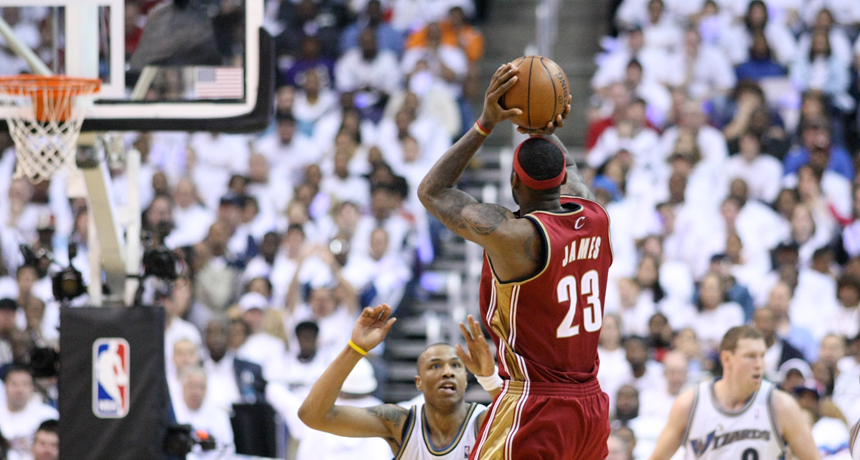
LeBron James, shown taking a shot for the Cleveland Cavaliers in the April 27, 2008, playoff game against the Washington Wizards, may never have a hot hand by scientists' definition, but they don't have to guard him.
Keith Allison/Flickr
- More than 2 years ago
It’s time for the beginning of basketball season, and science writers’ thoughts turn to how to rip on LeBron James.
One obvious approach would be to allege that LeBron has never, ever had a hot hand. To which many fans would say, “Are you kidding?” LeBron has had a hot hand lots of times. Just never in the fourth quarter in the NBA finals.”
But science supposedly argues otherwise. Studies have shown that the hot hand phenomenon does not exist for anybody. Not even LeBron. Or Michael Jordan or Larry Bird or Ray Allen. A widely cited paper by cognitive psychologists in 1985 presented an analysis of basketball statistics concluding there was no such thing as a hot hand. Hot hands were simply cognitive delusions in the minds of fans who didn’t understand the statistical probabilities of successful shooting streaks, the psychologists contended. And the scientific community (and most science writers) swallowed it whole.
In one new paper, for instance, computer scientists from the University of Colorado studied scoring patterns in several sports and found statistical regularities in the timing of “scoring events.” The researchers cited these regularities as further evidence against the existence of hot hands.
But it’s all baloney, of course. Such studies do not show that the hot hand phenomenon does not exist — only that scientists don’t know how to define or measure it.
Researchers in the new paper (and their predecessors) defined “hot hand” as the idea that making a shot increases the probability of making the next shot. This is the sort of thing that can readily be calculated from the data, so that’s why they define it in that way. But no basketball player (or knowledgeable fan) would accept that definition.
Starting with this wrong definition, analysis of lots of data turns up no evidence for hot hands. There will be streaks, though, where one player makes, say, six shots in a row. But such streaks show up no more often that you’d expect by chance, just the way a fairly flipped coin sometimes comes up heads six times in a row. Therefore “hot hands” are just lucky streaks, expected to occur by chance, the reasoning goes.
The trouble is, shooting basketballs is not like flipping a coin. The underlying mathematical premises simply don’t apply. (In the original paper debunking the hot hand, the authors acknowledge that problem, but simply say that it doesn’t matter, because each player selects at random from an ensemble of shots with varying difficulty. More baloney attempting to justify the methodology.)
So let’s say Player A makes six shots in a row. Does he have a hot hand? It depends. Suppose he made two uncontested layups off fast breaks, dunked one off a lob on an inbounds play, hit a short jumper in the paint, tipped in a rebound off a teammate’s missed shot and then banked one in coming off a pick ’n’ roll. Six made shots in a row, but nobody in the stands would start muttering that wow, that guy has a hot hand.
Now suppose Player B hits two three-pointers from deep in the right corner, another one from the top of the key, hits a jumper from just inside the three-point line on the left wing, sinks an 18-footer from the baseline and then drops in a fadeaway from the elbow. Now the broadcasters are going to be exclaiming things like “Player B, en fuego!”
In the data, the two scenarios look the same. To anyone watching the game, or who knows anything about the game, they are very different — one a hot hand in action, one not.
More recently, some researchers have tried to look more closely at the game by analyzing video, not just numbers. In that way the difficulty of the shot can be taken into account, and in this case there does seem to be a small hot hand effect, in which making a shot does increase the probability of making the next, if slightly. (This work uses a much more sophisticated statistical definition of hot hand.)
As I’ve written before, a hot hand “reflects a complex, subjective psychological and physiological state of mind and body” (SN: 2/2/11, p. 2). No definition based on statistics can capture that.
Strangely, the scientists who first debunked the hot hand must have known that the definition they used was deficient. In another place two of those authors quote an NBA player (Purvis Short of the Golden State Warriors) describing the hot hand. “You’re in a world all your own,” he said. “It’s hard to describe. But the basket seems to be so wide. No matter what you do, you know the ball is going to go in.”
Exactly. Hot hands have to do with what’s going on inside the head of the player, not the fan. Until you get the NBA to allow players to wear fMRI helmets during the game (and shoot without moving their heads), you’ll never have the data you really need to identify how hot hands work.
Note: This post was updated at 1:15 p.m. EDT to clarify the definition of hot hand used in the study described in the 12th paragraph.
Follow me on Twitter: @tom_siegfried






